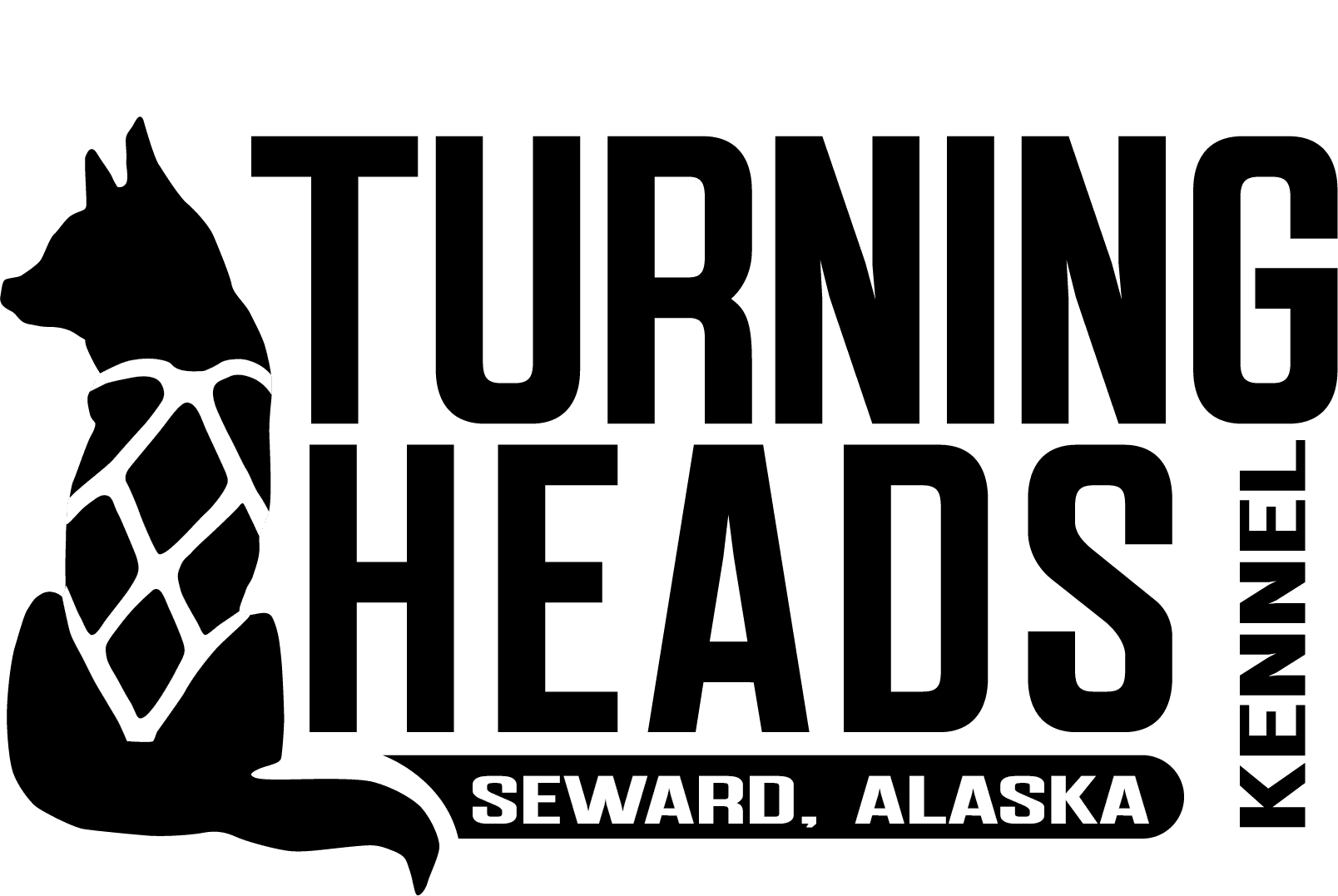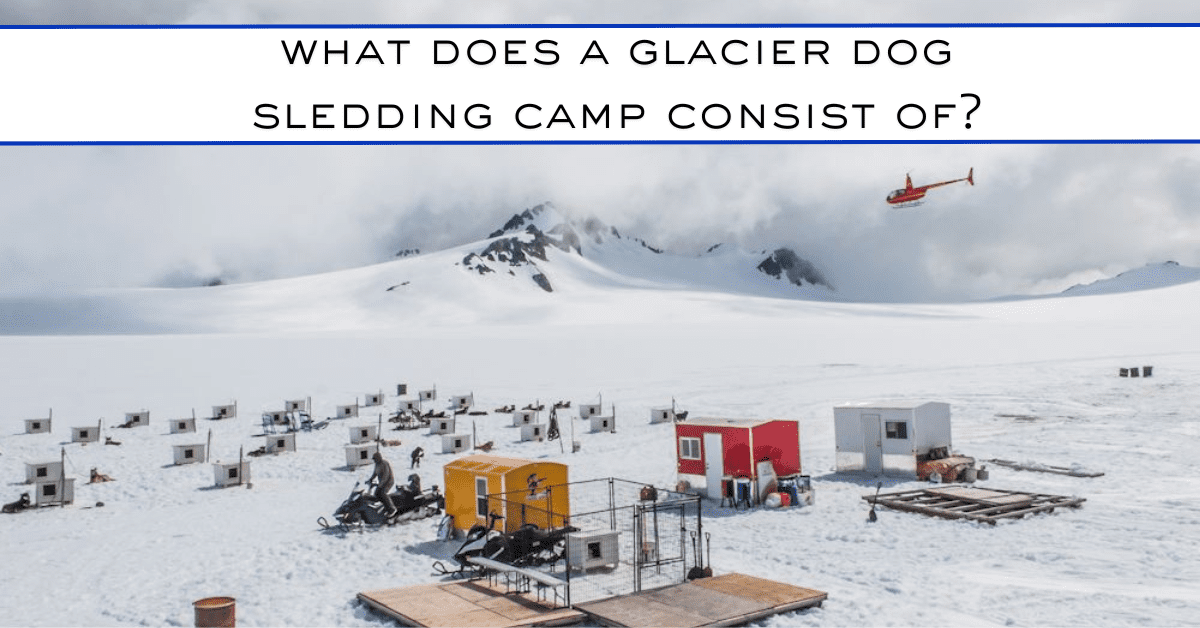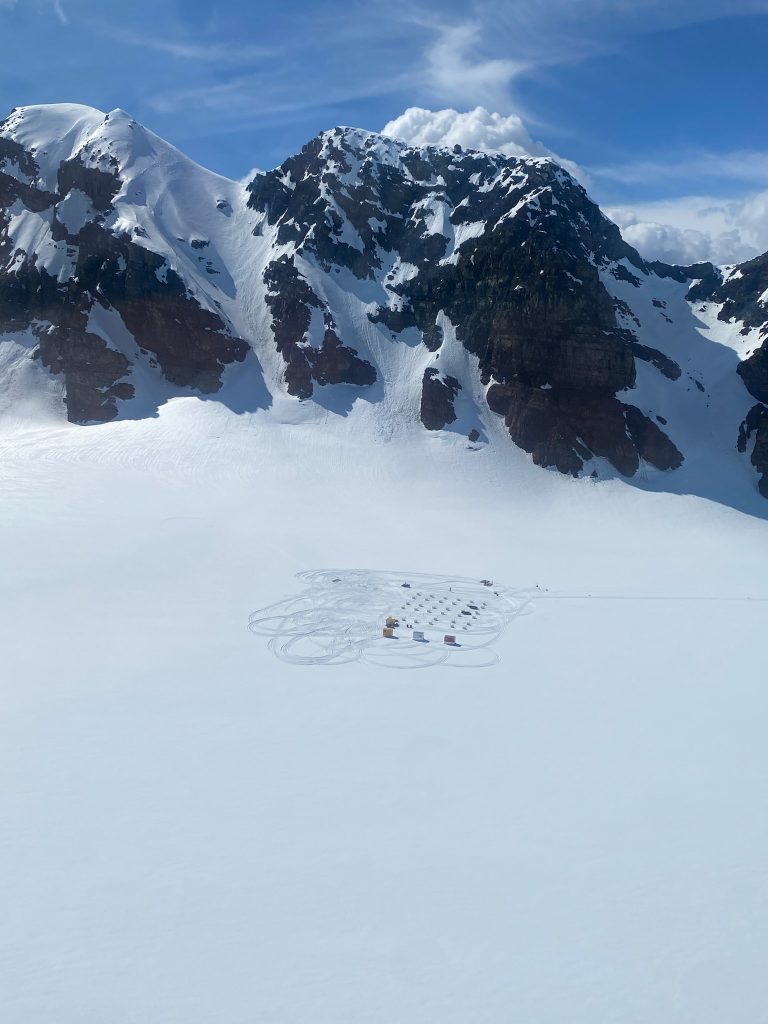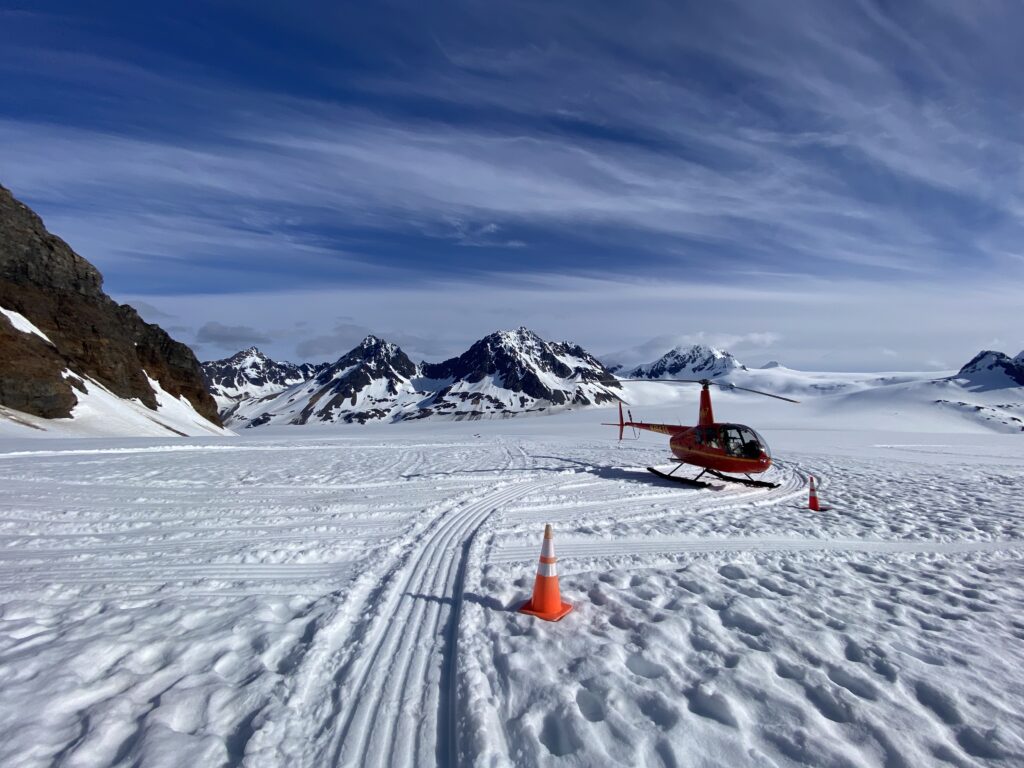A glacier dog sledding camp is a specialized seasonally dog camp located on a glacier, designed to facilitate dog sledding activities. These camps are typically operational during the summer months in regions where glaciers are accessible and safe for both humans and animals. These remote camps are accessed via helicopter. The entire glacier dog sledding camp is brought up to the glacier in late spring and taken down at the end of summer or when there is no longer enough snow for tours to safely operate.
Everything brought up to the glacier is brought via helicopter. Helicopters have the unique ability to haul external cargo using a long line. This is commonly referred to as slinging. Different helicopters have different limits on how much weight they can carry. Often, it takes smaller camps at least a dozen sling loads to set up camp. The larger camps in southeast Alaska 3 or 4 dozen loads.
A glacier dog sledding camp typically consists of a dog yard, guest area, and guide living quarters.
The Dog Yard at a Glacier Dog A Glacier Dog Sledding Camp
A dog yard at a remote glacier dog sledding camp generally consists of sled dog houses, pens, and big wide rows for the trail to go through. Each dog in a dog yard has its ts own house where the dogs can rest, eat, and stay when they are not working. The houses are designed to protect the dogs from the cold glacier surface and to keep them comfortable in the unique glacier environment. Some camps use plastic houses whereas others prefer wood. We use wooden houses in our camp as we have found that is what our dogs prefer.
Pens are often used to house puppies who go to the glacier to be socialized by visiting tourists. In larger camps, pens may be used to help separate female dogs who come into season.
A Dog Yards at a Glacier Dog Sledding Camp Presents Unique Challenges
A dog sled yard on a glacier is a lot more work than an ordinary dog yard. That’s because a glacier is an environment that changes frequently throughout the summer due to snow melt. Snow melt comes not only from warm temperatures but also from rainfall. Anything on the glacier absorbs heat and those areas can melt faster. This means everything we bring up has to constantly be moved around.
Being good stewards requires that a glacier dog sledding camp is leave no trace. Everything brought up to the glacier, has to come down. This includes dog waste. In our camp, waste is collected in 55 gallon drums that are flown off the glacier. The dog waste is then pumped by a local company. Other camps may use trash bags or buckets.
Because dogs shed, we must constantly rake up where the dogs live to collect their hair. To alleviate how much the dogs shed on the glacier, we will often groom our dogs before they go up to our dog sledding camp. When tours are not being run because of weather, guides will often brush dogs and bag their hair too.
Besides picking up waste and dog hair, there is a lot of maintenance that goes into taking care of the dog yard. As mentioned, the glacier is slowly melting. This often leads to dog houses needing to be leveled so that they are comfortable for the dogs. Every few weeks, the dog yard may be moved so that the dogs have a level surface. The yard is not moved far: maybe 10 or 15 yards. Along with leveling the houses, the trail that runs through the yard needs to be maintained. This is groomed with a snow machine and groomer, often nightly, to ensure a smooth surface for both the dogs and guests.
The Glacier Dog Sled Trail runs through the Glacier Dog Sledding Camp
The dog sled trail runs through our camp. Often, there will be several “chutes” that feed into the team. This allows the dog sledding guides and their handlers to easily hook up dogs. It also makes it so that the teams never have to turn around. By running in a big circle, the teams can go on a second run or be easily swapped out for a new dog team.
The trail is often maintained by a snow machine pulling a custom built groomer. This helps keep the trail easier for the dogs. By grooming at night, the trail often will firm up and provide an easier surface for the dogs to pull.
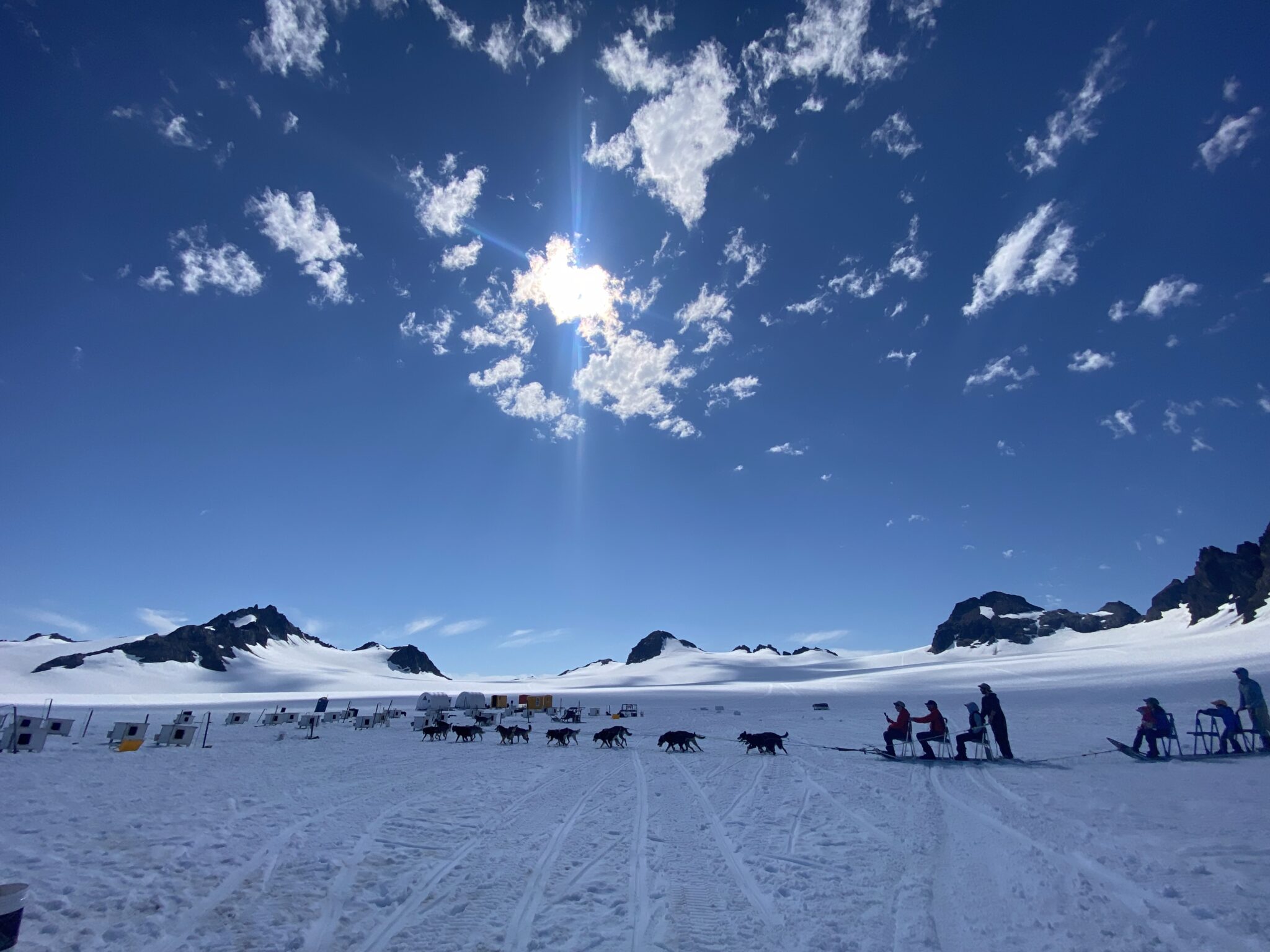
By the chutes, harness racks and other mushing equipment is kept. A glacier dog sledding camp will have a number of dog sleds ready for use, designed specifically for glacier conditions. We have sleds that accommodate 2, 3 or 4 passengers based on the groups we have visiting. We like families to be able to mush together. Large families may have to go out on two separate teams but will be near each other on the trail. Our dogs are quite strong but we do not want to overwhelm them by putting too many people on one sled.
The Guest Area of a Glacier Dog Sledding Camp
The guest area of a glacier dog sledding camp is often near the helipads where the helicopters come in to land. The helipads are often denoted by markers like traffic cones. A wind sock may also be nearby to help the pilots determine the wind direction. The helipads are simply areas of the glacier that have been groomed. Landing in a groomed spot is easier for the pilots and for guests unloading and loading into the helicopter. Again, the glacier is often melting so snow can sometimes be soft and punchy.
Near the helipad, is often benches, platform, or tent for guests to meet at. In our camp, our guests exit the helicopter and generally make their way to either a platform or puppy pen. Having a visual reference for guests to walk to when exiting the helicopter is extremely helpful.
Besides being the area where guests will learn about how to mush and interact with dogs, this area often has a tent with emergency quarters should guests have to stay overnight. Because helicopters fly by visual flight regulations, they need good visibility to see. Glaciers can be unpredictable and weather can change quickly. No one ever wants a pilot to feel pressured to fly in unsafe conditions so the best solution is to always be prepared to have guests stay for an extended period of time. In our experience, this does not happen often, perhaps once a season if that, but it can occur.
Guide living Quarters on a Glacier Dog Sledding Camp
Accommodations for the mushers (sled drivers) who live at the camp for the season vary by company. In general, these might be tents or other temporary structures. Our own camp uses modified ice fishing huts. Other camps use weather ports.
Our guides have private “rooms” while at camp but share cooking facilities and a rudimentary honey-bucket style toilet. We also have a gear shed. The gear shed is used to store dog food, miscellaneous mushing gear, and other items.
Living on the glacier is hard work because you are constantly walking in soft snow. Although driving the dogs and taking guests on glacier dog sledding tours is an important part of the job, a big part that goes unseen is maintaining camp. Everything at camp constantly needs to be leveled and moved. If a building, for example, is not moved it could melt out on only one end. This would result in the building becoming unstable.
Life as a Glacier Dog Sledding Guide
Because of the unique challenges living on a glacier presents, glacier dog sledding guides must be incredibly tough. Working in soft snow and wet conditions means that glacier dog sled guides must be physically fit and have a resilient personality. They also must be comfortable with solitude. When tours are done for the day, the guides still have chores to do. They live on the glacier, often spending 4-5 days in a row up top in small teams. It’s an incredibly unique experience.
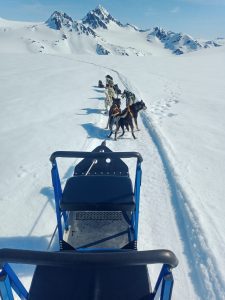
Conditions vary throughout the season. Guides must be prepared to endure weather stretches when the helicopter cannot fly. Often, this only lasts 1 or 2 days but can be longer. This means the camp always has to be well supplied with essentials like dog food, propane (used for cooking and heat), potable water for humans, food, and gasoline. Our camp relies primarily on solar power, however, during inclement weather gasoline powered generators help staff stay in contact with our ground support staff.
Glacier Dog Sledding Camp Removal
When glacier dog sled tours are done for the season, the task of removing the camp begins. Taking down the camp often takes several days. First, the dogs are removed from camp and flown off the glacier. The dogs are flown in a custom box that goes inside the helicopter that holds 4 or 5dogs. Guides must take apart dog houses and the helicopter pilots must build external loads. Slowly, everything is removed from the glacier. A final cleanup is done to ensure that the space is cleaned. It is important to be good stewards of the glacier and a proper clean up is important.
Finally, after the gear is flown off the glacier it is dried out and repaired. Then gear is stored for the following season for the entire process to begin again the following season.
